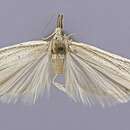Conservation Status
由University of Alberta Museums提供
Rare in Alberta and apparently restricted to sand dune areas.
- 許可
- cc-by-nc
- 版權
- University of Alberta Museums
Cyclicity
由University of Alberta Museums提供
Late June to August.
- 許可
- cc-by-nc
- 版權
- University of Alberta Museums
Distribution
由University of Alberta Museums提供
Described from Pullman, Washington, by Dyar. Otherwise known from southern Alberta and Washington, south through Washington and Colorado to California and New Mexico (Shaffer, 1968). A specimen collected by K. Bowman at Medicine Hat, Alberta, on June 24, 1945 is in the Canadian National Collection (CNC) (Shaffer, 1968). A series was collected on August 12, 2008 by Gary Anweiler in the Middle Sand Hills, 57 km NE of Suffield, Alberta.
- 許可
- cc-by-nc
- 版權
- University of Alberta Museums
General Description
由University of Alberta Museums提供
A small Pyralid with a wingspan around 21 mm. Both fore and hind wings are yellowish white above, the forewings being sprinkled with brown scales. The frons is conical as in other Bandera species but the costal area of the forewings is yellowish white, not all white as in Bandera binotella which also has black spots on the posterior part of the forewings, or basally white as in Bandera cupidinella. Similar to Coenochroa illibella but lacking a pale to whitish FW costa. Also similar to Anerastia lotella but smaller and the frons is conical rather than being rounded. Very different from Peoria approximella in which the labial palpi, frons and area of the fore wings above between the costa and anal vein is blood red to orange red. The genitalia are described and illustrated by Shaffer (1968) while the moth is illustrated by Neunzig (1990).
- 許可
- cc-by-nc
- 版權
- University of Alberta Museums
Habitat
由University of Alberta Museums提供
Sand dune areas.
- 許可
- cc-by-nc
- 版權
- University of Alberta Museums
Life Cycle
由University of Alberta Museums提供
Unknown.
- 許可
- cc-by-nc
- 版權
- University of Alberta Museums
Trophic Strategy
由University of Alberta Museums提供
Unknown.
- 許可
- cc-by-nc
- 版權
- University of Alberta Museums
Bandera virginella: Brief Summary
(
英語
)
由wikipedia EN提供
Bandera virginella is a species of snout moth in the genus Bandera. It was described by Harrison Gray Dyar Jr. in 1908, and is found in the US from southern Alberta and Washington, south through Colorado to California and New Mexico.

